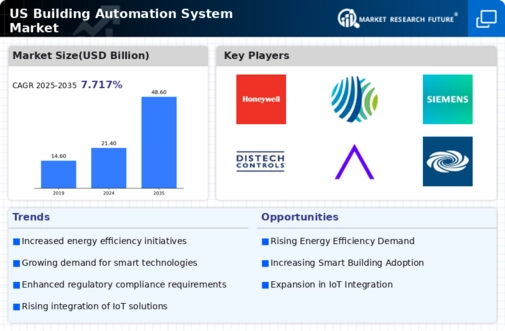The US Building Automation System Market is characterized by a dynamic landscape filled with key players that are continually innovating and adapting to the changing needs of consumers and businesses. The market encompasses systems that integrate various building functions, including lighting, HVAC, security, and energy management, to create a more efficient, sustainable, and secure environment. The competitive insights reveal that companies within this space strive to develop advanced technologies and solutions that provide better operational efficiencies and enhance user experience.
Factors such as regulatory standards, growing energy concerns, and the trend towards smart buildings are influencing the strategies employed by these companies. Technological advancements, increased demand for energy-efficient solutions, and a shift towards digital transformation are driving growth in the sector, leading to an intense competition among market players. Focusing on Honeywell within the US Building Automation System Market, the company stands out due to its broad range of solutions designed to enhance building efficiency and sustainability.
Honeywell's strength lies in its commitment to innovation, investing heavily in research and development to introduce cutting-edge technologies that cater to diverse customer needs. The company benefits from a robust market presence, having established itself as a trusted name in the industry, offering advanced features like IoT integration, real-time monitoring, and predictive analytics. Its strong relationships with various stakeholders, including installers and contractors, further solidify Honeywell's position in the market. Moreover, Honeywell's proactive support in helping clients transition to more sustainable practices through energy-efficient solutions enhances its competitive edge.
Control4 also plays a significant role in the US Building Automation System Market, focusing primarily on providing residential and small commercial solutions. The company is known for its high-quality smart home automation products that integrate seamlessly with various devices to deliver a unified experience. Control4's strengths lie in its user-friendly interfaces and customizable systems, enabling homeowners to manage their lighting, climate, security, and entertainment from a single platform. The firm has a strong market presence due to its emphasis on enhancing customer experience and its commitment to innovation in automation technology.
Furthermore, the company has pursued strategic mergers and acquisitions to broaden its product offerings, strengthen its market position, and widen its distribution channels. These strategic moves have positioned Control4 favorably within the competitive landscape, appealing to both tech-savvy consumers and those looking to simplify their building management systems.





















Leave a Comment